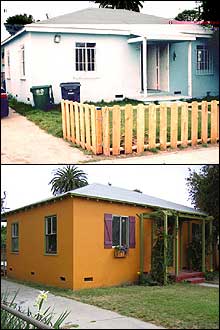BEND, Ore. (CNN/Money) – There may be no such thing as a free ride or free lunch, but what about a free coat of paint?
That was the offer Affinity Neighborhoods, a private investment group, extended to residents in the Los Angeles suburb of Compton on a recent Saturday. With $5,000 in supplies and 50 volunteers, the group painted five houses and planted 100 trees in one day.
"The residents really responded," said Richard Hollingsworth, president of Gateway Cities Partnerships, a community development group that works in Compton and other cities. "It got them thinking about what else they could do to improve their homes."
Affinity, which owns 20 single-family houses in Compton, is already making plans for similar clean-up events. Not only do they hope to spark some good old-fashioned neighborhood pride, the group may also make a good old-fashioned profit.
Strength in numbers
In 1996, David Frayne, now Affinity's head of research and development, rallied friends and family to buy property in Oakland, Calif., where real estate was cheap compared to prices in San Francisco. He thought they stood a better chance of improving their property values by buying in the same neighborhood and fixing up their houses at the same time.
"It was kind of an experiment," said Ingrid Johanns, who was one of 10 people who bought 16 houses that year and is now Affinity's president and CEO. The experiment proved a success. The houses have sold or are in contract to sell for about twice what each buyer paid.
 |
|
| Affinity Neighborhoods bought this Compton, Calif. house, fixed it up, then offered to help the neighbors spruce up their homes. |
After property values shot up in Oakland, Frayne suggested his friends and family buy in Long Beach, a city south of Los Angeles that seemed undervalued at the time. Again they bought 16 houses and duplexes, and once more they saw a jump in their property values.
Eventually, said Johanns, then working as a project manager for Chevron/Texaco, "I called David and said 'Let's team up and make this a real business.'"
In 2003, they formed Affinity Neighborhoods and began accepting investments for their first private fund, Affinity Properties, LLC. The fund now has 22 investors, 31 properties, $1.7 million in invested capital and an estimated $7.8 million in real estate. Its projected return on investment for the 12-months ending in August is 70 percent.
Hassle-free property ownership
Affinity isn't the first group to create a fund for investing in single-family homes.
In 2002, Washington D.C.-based Redbrick Partners began soliciting friends and family members to invest in a similar fund. Redbrick now owns about $10 million in single-family properties in what managing partner Thomas Skinner calls "working-class" communities in the Northeast, such as Hartford, Conn., and Trenton, N.J.
"Single-family housing is a $13 trillion asset class, with attractive returns, low volatility and low correlation with other asset classes," said Skinner, an MIT economics Ph.D. and former McKinsey & Co. consultant. "But there is no simple way to put money to work investing in housing."
Not yet anyway. "Our expectation is to grow to a multibillion dollar manager of assets," said Skinner, whose fund is up 30 percent in 2004.
Like most private funds, Redbrick and Affinity have high minimum investments – $100,000 and $50,000 respectively – and require that investors have at least $200,000 in income or a net worth of at least $1 million.
Redbrick, which will close a second fund at the end of this month, requires a seven-year commitment from investors, charges a 2 percent management fee and takes 15 percent of profits, said Skinner.
Affinity, which is accepting applications until August for its second fund, Leonardo LLC, requires a two-year commitment and charges no management fee unless it can generate a 25-percent return for its investors, at which point it charges a fee of 50 percent of profits.
Though the funds are based on similar concepts, they follow different approaches.
"Our strategy is to buy and hold and generate rental income," said Redbrick's Skinner. "It's a lower risk approach."
In contrast, Affinity focuses on buying undervalued property, fixing it up and selling it for a profit.
That said, one of Affinity's goals is to have a positive impact on the neighborhoods where it buys – and not just because it's good for returns, said Johanns.
Of course, skeptics could argue that Affinity will only price out the same people it says it's trying to help. "We're very sensitive to this," said Johanns, who as one solution gives tenants a lease-to-own-option.
"Frankly these aren't neighborhoods yuppies will move into," added Gateway's Hollingsworth.
His hope is that new investment will help boost the property values of existing homeowners and bring back residents who grew up in the area, went to college and could now be leaders in the community.
"I don't call that gentrification," he added. "I call that reinvestment."

|